Cathedral Church of St. James (Toronto)
The Cathedral Church of St. James is an Anglican cathedral in Downtown Toronto, Ontario, Canada. It is the church of the oldest congregation in the city, with the parish being established in 1797. The cathedral, with construction beginning in 1850 and opening for services on June 19, 1853, was one of the largest buildings in the city at the time. It was designed by Frederick William Cumberland and is a prime example of Gothic Revival architecture.[5]
| Cathedral Church of St. James | |
|---|---|
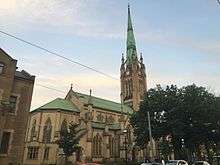 Exterior | |
%26groups%3D_d7c34164f7c830acd31524e79d45e75a64099999.svg)
| |
| 43°39′01″N 79°22′26″W | |
| Location | 106 King Street East Toronto, Ontario M5C 2E9 |
| Denomination | Anglican Church of Canada |
| Churchmanship | High church |
| Website | stjamescathedral.ca |
| History | |
| Founded | 1797 |
| Dedication | Saint James |
| Consecrated | 1853 |
| Administration | |
| Deanery | St. James |
| Diocese | Toronto |
| Province | Ontario |
| Clergy | |
| Bishop(s) | Andrew Asbil[1] |
| Rector | Stephen Vail (Dean of Toronto)[2] |
| Vicar(s) | Louise Peters |
| Priest(s) | Andrew MacDonald James Liu Walter Hannam (Vicar of St Bartholomew's)> |
| Laity | |
| Organist(s) | David Simon[3] |
| Organ scholar | Patrick McElcheran[3] |
| Type | Municipally designated |
| Designated | September 26, 1977 |
| By-law No. | 588-77[4] |
The church building is designated under the Ontario Heritage Act,[4] and it is the episcopal seat of the Anglican Church of Canada's Archbishop of Toronto. Royal St. George's College, on Howland Avenue, is the church's choir school and is open to boys in grades 3 through 12.
History
The Anglican parish of St. James was established in 1797 in the then-town of York. In 1807, the first church was built of wood. It was used in 1813 during the War of 1812 as a hospital and subsequently robbed and damaged by the American troops. Shortly after, in 1818, the church was enlarged and a bell tower addition was completed. The bell was used as a fire bell for the town. In 1833, the wooden structure was taken down and replaced by a stone structure in the Neoclassical style. In January 1839, the church burned down and was reconstructed. Upon reopening in December 1839, the church became a cathedral. St. James Cemetery, the parish cemetery, was moved in the 1840s to St. James-the-Less at Parliament and Bloor, although there are still unmarked graves under the modern parking lot.
In 1849, the cathedral was destroyed in the first Great Fire of Toronto. An international architectural competition was held to replace it, drawing eleven entries from Canada and the United States. Frederick William Cumberland and Thomas Ridout's Gothic Revival design placed first, followed by the submissions of John Ostell and Kivas Tully respectively.[6] Construction began on July 1, 1850, and the Ohio stone and brick cathedral was opened to the public in 1853. The cathedral's original organ was built in 1853 by Samuel Russell Warren.
Upon his death in 1867, John Strachan, Toronto's first Anglican bishop, was buried in a vault beneath the high altar. Dean Henry James Grasett (1808–1882) was also buried here.[7]
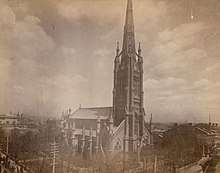
It was not until 1873–1874 that the tower and spire, the transepts, and the pinnacles and finials were completed by architect Henry Langley.[8] The spire was the tallest structure in Canada upon completion and would remain so for another 25 years until the construction of Toronto's Old City Hall. The tower's clock was installed one year later. In 1889, side galleries and aisles were removed, and the choir stalls and organ console were installed in the chancel. In 1936, St. George's Chapel was dedicated, and the organ was overhauled by Casavant Frères.
Major renovations were completed in 1982. The parish celebrated its bicentenary in 1997, when the peal of 12 change ringing bells was installed as the largest peal in North America. They are one of only nine peals of 12 bells[9] outside the British Isles, and one of only two in North America, the other being located at Trinity Church in New York City.[10]
To raise money to help pay for the rising costs of maintaining the cathedral, part of the grounds were planned to be sold to a condominium developer. Part of the land was to have been part of the original cemetery, and the developers planned to move the graves in order to clear the land. A public outcry ensued, and a deal was made to sell off a parking lot to the northwest of the cathedral for the SP!RE condominium development.
Notable funerals
In addition to the funerals of former Bishops of Toronto, there have been notable funerals at St. James for other prominent people from the Toronto area, including:
- George Snell (1907–2006), former Bishop of Toronto from 1966 to 1972[11] – funeral in 2006
- Ted Rogers (1939–2008), businessman and founder of Rogers Communications – funeral on December 9, 2008
- Jim Flaherty (1949–2014), former Ontario MPP, federal MP and minister of finance – state funeral on April 16, 2014
- Rob Ford (1969–2016), former Mayor of Toronto and city councillor (Ward 2) – civic funeral on March 30, 2016
The Rev. George Okill Stuart, who served from 1800 to 1812, and the Rev. John Strachan are the only graves located within the cathedral.
Architecture
St. James Cathedral's Gothic Revival architecture is reflected throughout the structure. Every part of a Gothic cathedral is directly related to a "core dimension" which is used as an effort to achieve harmony and organic unity within the building where everything is linked rationally and proportionally, creating a coherent whole. Every element in the cathedral—including the stained glass windows, the pointed arches, high ceilings, the pinnacles, even the flying buttresses—allow as much light as possible to flood the interior. The Gothic style means an aesthetically unified whole, but the combination of different architectural elements such as the ribbed vaults, flying buttresses, and pointed arches allows for generous illumination of the interior space with natural light.
Exterior
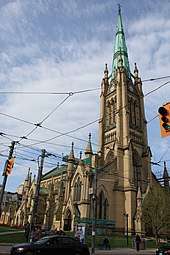
The cathedral's exterior is composed of white brick and Ohio sandstone. Several layers of brick in the facade create strong, square inset designs around the lancet windows of the clerestory. This allows for a play of light and shadow that dramatizes the heaviness of the wall, and was the effect of emphasizing the wall's depth by partially cutting into it. The spires are built of stone and decorated with pinnacles and dormers, and ball flower ornaments atop the pinnacles. Tower walls are reinforced with square and octagonal buttresses that taper abruptly with generous weatherings at transitional points and terminate in pinnacles, some with slender colonettes abutting chamfered edges, with ribbed, stepped, or gable caps. These buttresses are accented by heavy weatherings in lighter coloured stone (creating visual contrast while drawing attention to the points of stress on the building), and topped with pinnacles, thus emphasizing their massiveness, structural function, and verticality. They provide spatial rhythm on the east and west facades.
A careful balance between horizontal and vertical elements can be observed throughout the interior and exterior of the church. On the exterior, a dog-toothed fret runs along the aisle roofline, while on the interior, a band of continuous painted bosses similarly run along the top of the aisle wall. These horizontal bands balance the composition against the verticality of the exterior tower and pinnacles, and the interior pointed arches of the nave arcade, creating a sense of stability and repose.
At 92.9 metres (305 ft), the tower and spire have remained the tallest in Canada and the second tallest in North America after St. Patrick's Cathedral, New York—although the spire of St. James is still shorter than the dome of Saint Joseph's Oratory in Montreal, which is the tallest church in the Western Hemisphere. The tower has five bells that still ring through the city today, and the chiming clock is "one of the finest examples of a chiming public clock anywhere in the world."[12] At the turn of the 20th century, St James' Cathedral was still the tallest building in Toronto, and was often the first thing immigrants noticed when they stepped off the train at the old Union Station.
The total length of the cathedral is 198 feet (60 m), with a maximum width of 98 feet (30 m). A four sided arch with steeple was erected alongside the cathedral as a military memorial.[13]
Interior
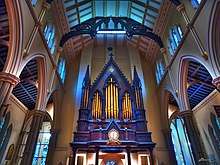
Over the principal entrance, a carved organ cover rises over a royal coat of arms, while Minton tile-work lies underfoot. The organ has 5000 pipes and includes the original gallery organ from 1853 over the main south entrance at the rear of the cathedral. Trumpet pipes have since been added to the gallery organ. The front chancel and aisle pipes were added in 1916.
In the interior, the absence of galleries frees the vertical movement of the arcade and clerestory.[14] A high-pitched roof of heavy timber, crowned with enriched ribs and carved bosses creates a sense of shelter to the nave. The exposed rafters of the roof of the nave are articulated structural elements, and broad tie-beams and decorative cornices accent the joints. The elegant vault of the apsidal chancel, though expressing the thrust from the vault in the ribs that flow down to the ground, is a sham vault of lath and plaster that is coloured to represent stone.[15]
The division of the interior into six bays is reflected on the exterior by the buttresses along the east and west elevations. Pews flow through the arcade in rows of four, gallery fronts, and chancel panelling is all black walnut, as are the Corinthian capitals. Glazing bars of windows in sash of varying widths are reminiscent of Gothic tracery, creating divisions in the stained glass.
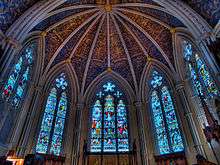
The cathedral is oriented on a north-south axis, whereas the traditional orientation is on an east-west axis with the altar at the east end. The orientation, decided by the design committee at the time, conforms to the symbolic representation of the church at the time, where the conflict with the American troops was apparent. The pews are oriented in central rows, with aisles on each side. The comfort of the seating was not highly regarded in the design.
Music
Uniquely within the city of Toronto, the fully professional 18-voice cathedral choir sings at the Eucharist (11:00 am) and Evensong (4:30 pm) each Sunday. Its repertoire spans eight centuries. Choral Eucharist is also celebrated at 9:00 am each Sunday and is sung by a group of volunteers.
The cathedral's pipe organ can be heard in recitals each Tuesday at 1:00 pm and Sunday at 4:00 pm throughout the year. The recital series is curated by the cathedral's organist, David Simon.
St. James Park
| St. James Park | |
|---|---|
View of the formal gardens and fountain, with St. Lawrence Hall in the background | |
%26groups%3D_56c89960e2fb3b98deb032e3bb1dd52b385ec3b8.svg)
| |
| Location | 120 King Street East Toronto, Ontario |
| Coordinates | 43°39′03″N 79°22′23″W |
| Operated by | Toronto Parks |
| Website | St. James Park webpage |
To the east of the Cathedral is St. James Park, an urban public park that is owned by both the church and the City of Toronto government. The park is bounded by the Cathedral to the west, Adelaide Street East to the north, Jarvis Street to the east and King Street to the south. It is located across King Street from St. Lawrence Hall.
Created in the early 20th century (the east and south sides around the park required demolition of a series of three-storey buildings), the park's Postmodern landscaping is Victorian-inspired, with formal gardens and a water fountain.[16] Two walkways with park benches cross the park diagonally, with a large ornamental gazebo in the middle functioning as a central meeting place.
The formal gardens are located in the southern quadrant of the park as defined by the X-shaped walkway plan, and the formal gardens have two paths intersecting at the fountain. Maintenance of the park is performed by Toronto Parks staff, and the formal gardens are tended by members of the Garden Club of Toronto. The park is often used for wedding photo shoots. In fall 2011, the park was occupied by members of Occupy Toronto.
See also
References
- "Bishop of Toronto". Anglican Diocese of Toronto. Retrieved November 23, 2018.
- "Stephen Vail appointed Rector of St. James Cathedral and Dean of Toronto". Cathedral Church of St. James. Retrieved August 24, 2019.
- "Staff & Lay Leaders". Cathedral Church of St. James. Retrieved September 13, 2019.
- "City of Toronto's Heritage Property Inventory". City of Toronto. Retrieved August 15, 2013.
- "Archived copy". Archived from the original on March 20, 2012. Retrieved March 7, 2011.CS1 maint: archived copy as title (link) Ontario Heritage Trust St. James' Church
- Arthur, Eric (1986). Toronto: No Mean City. Toronto: University of Toronto Press. p. 131. Retrieved February 22, 2011.
- Turner, H.E. "Grasett, Henry James". Dictionary of Canadian Biography. 9. Retrieved February 22, 2011.
- Arthur, Eric (1986). Toronto: No Mean City. Toronto: University of Toronto Press. p. 136. Retrieved February 22, 2011.
- https://dove.cccbr.org.uk/dove.php?searchString=&numPerPage=10&searchCountry=Rest+of+World&searchDiocese=&searchPracN=&searchRingable=&searchBells=12%2B&searchNote=&searchAmount=%3D&searchWeight=&searchMetric=cwt&searchDetails=&searchGF=&searchSimulator=&searchToilet=&sortBy=Bells&sortDir=Asc&Submit=Go
- https://www.youtube.com/watch?v=g5ZaF8jlhGs&t=637s
- http://www.anglicanjournal.com/articles/snell-was-a-real-missionary-bishop-7051
- Lockhart, Rob. "The Great Tower Clock of St. James". Archived from the original on May 24, 2011. Retrieved February 22, 2011.
- "Memorial: Four sided arch with steeple alongside the Anglican St. James Cathedral". National Defence Canada. April 16, 2008. Archived from the original on May 23, 2014. Retrieved May 22, 2014.
- Morris, Shirley G.; Benn, Carl (1998). The Parish and Cathedral of St. James', Toronto, 1797-1997: A Collaborative History. Toronto: University of Toronto Press.
- Simmins, Geoffrey (1997). Fred Cumberland: Building the Victorian Dream. Toronto: University of Toronto Press.
- St. James Park webpage
External links
| Wikimedia Commons has media related to Cathedral Church of St. James. |